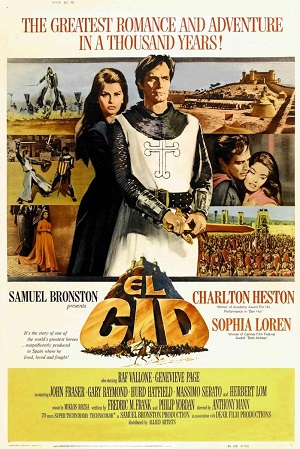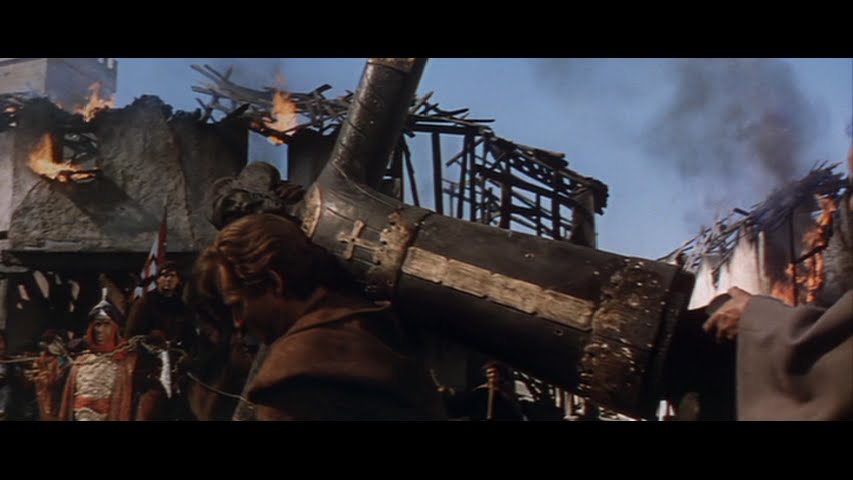Twisting History at The Movies
So many of the stories we tell are about building heroes up- see Campbell, Joseph- but after reading Dune, I wanted to tear them down. I discovered a book, Heroes, Saviors, Traitors, and Supermen, by historian Lucy Hughes-Hallett, which has stuck with me almost as much as Dune has. Heroes is a collection of biographies, all of them fascinating characters, but one stood out:
Rodrigo Diaz de Vivar is not well-known in the U.S., but he is a mythic figure in his native Spain. He’s better known as El Cid[ref]Probably a corruption of the Arabic al Sayyid, or "the lord."[/ref], and is something like the lovechild of King Arthur and Robin Hood: He's  a brave, chivalrous knight, but also has the reputation as a man of the people, who brought treasure and glory to those who fought beside him.
a brave, chivalrous knight, but also has the reputation as a man of the people, who brought treasure and glory to those who fought beside him.
It’s hard to separate fact from fiction when it comes to El Cid. Even the most contemporary sources are wildly exaggerated. He comes with the usual fantasy accessories: he wields a sword, Excalibur Tizona, made from Damascus steel, and rides a noble steed, Donkey Babieca.
When he lost favor with his lord, King Alfonso VI of Castile, Rodrigo was exiled and went to work for several Muslim kings nearby. The country we call “Spain” didn’t exist in the late 11th Century- it was more a collection of lords and castles with various amounts of regional control. Some were Christian, like Alfonso, and some were Muslim- the remnants of Islamic armies that invaded the Iberian Peninsula centuries before. But El Cid was not some paragon of religious tolerance- all he cared about was who would pay him the best price (how else would his followers get their treasure and glory?)
Time and again in Hughes-Hallett’s biographies, some scheming politician tries to use the daring deeds of the likes of Francis Drake, Giuseppe Garibaldi, or El Cid for their own political gain. Especially after they’re dead, a Hero has no say in who tells their story.
A movie was made about El Cid in 1961. If you are so inclined, it stars Charleton Heston as Rodrigo, and Sophia Loren as his wife Jimena. The sets and costumes all look very expensive, and the music has a Phrygian, brassy bombast that’s a lot of fun. Beyond that… lets just say one of the first scenes finds Heston bearing a cross out of a burned out church. It’s like that. For three hours.
lets just say one of the first scenes finds Heston bearing a cross out of a burned out church. It’s like that. For three hours.
And the plot thickens. The film was made in cooperation with Generalissimo Francisco Franco, the fascist dictator who’d ruled Spain since the 1930s.[ref]To the best of our knowledge, he’s still dead.[/ref] Thousands of extras from the Spanish army were provided for the battle scenes.[ref]Hughes-Hallett, 11.[/ref]
Franco, you won’t be surprised to learn, fashioned himself during his rise to power as a latter day Cid,[ref]Domke, Joan, "Education, Fascism, and the Catholic Church in Franco's Spain" (2011). Dissertations. Paper 104. http://ecommons.luc.edu/luc_diss/104, pg 16[/ref]returning to save Spain from republicans, socialists, communists, and any religion that wasn’t Catholicism. He twisted historical events[ref]”In 1939, Franco made his triumphal entry into Madrid, after first issuing a press release declaring the occasion would ‘follow the ritual observed when Alfonso VI, accompanied by the Cid, captured Toledo in the Middle Ages.’ (When Alfonso took Toledo, Rodrigo was actually still in exile, serving the kings of Zaragoza.)” Hughes-Hallett, 418-419.[/ref], and cloaked himself in a messianic fervor.
Movie!Cid is everything Franco wanted to present himself as. The movie makes him seem almost divine. Consider the final scene: El Cid, defending the city of Valencia from Muslim Almoravids[ref]A literal faceless horde, cloaked in black, and carrying the cowhide shields of the Zulu, several thousand miles south. Nice job, props department.[/ref] from North Africa, is wounded by an arrow. The doctors can save him, but he’ll have to recover in bed for several days.
“No!” says El Cid. I paraphrase: “Let me die. But don’t tell anyone. Let the army think I'm still alive. Then, tomorrow, put me on my horse, open the gates, and let’s see what happens.”
What happens is El Cuerpo, dressed all in white like a medieval Klansman, charges into the swarm of mooks, sunlight glinting off his armor, accompanied by a pipe organ. [ref]Props to Heston’s equestrian skills- that is not easy to do.[/ref]
[ref]Props to Heston’s equestrian skills- that is not easy to do.[/ref]
Don’t believe me? Go ahead and see for yourself.[ref]Please forgive the botched aspect ratio.[/ref] I’ll wait.
To say this didn’t happen is an understatement. Even the myths and legends about El Cid don’t say he died like this. [ref]Hughes-Hallett, 12. There is a story about Rodrigo’s embalmed body riding Babieca back to Castile, but there was no battle involved. (Ibid, 170.)[/ref] Campbell’s Hero’s Journey calls the climax of the story “Apotheosis,” when the Hero becomes god-like. I can think of no better example than this.
Franco was not the first dictator to patronize a propaganda film about himself: In the 1930s, Joseph Stalin commissioned Sergei Eisenstein to make a movie about another folk hero, Alexander Nevsky, defending his village (the Soviet Union) from invading Germans. Did Franco end up saving Spain from anything? I’d argue no, and he killed an awful lot of people doing it.
At least he has his myth to make him feel better about it all.
When I watch the final shot of the film, with El Cid astride Babieca, galloping up the beach, I really hope he runs into a low hanging tree branch some time soon.
That poor horse.
